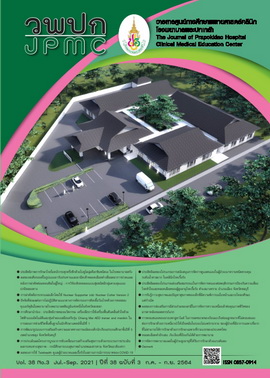ผลของการใช้ Telehealth ดูแลผู้ป่วยบาดแผลเรื้อรังในสถานการณ์การระบาดของ COVID - 19
Main Article Content
บทคัดย่อ
ที่มาของปัญหา: สถานการณ์การแพร่ระบาดของ COVID - 19 ส่งผลกระทบอย่างมากในการให้บริการทางการพยาบาลและการแพทย์ ลดการเข้ามารับบริการในหน่วยเฉพาะทางโดยเฉพาะอย่างยิ่ง บาดแผลเรื้อรังที่ต้องการดูแลรักษาพิเศษ เพื่อเพิ่มความมั่นคงในการเข้าถึงระบบการดูแลบาดแผลของผู้ป่วย และตอบสนองนโยบายกระทรวงสาธารณสุขเกี่ยวกับมาตรการลดปริมาณผู้ป่วยเรื้อรังในช่วงการระบาดของโรคติดเชื้อ COVID – 19 (prevention and control COVID - 19 transmission excellent) จึงจำเป็นต้องใช้นวัตกรรมและเทคโนโลยี Telehealth ผลักดัน Innovative healthcare management ปรับเปลี่ยนระบบบริการในรูปแบบ New normal การดูแลบาดแผลเรื้อรังอย่างมีประสิทธิภาพและยั่งยืน
วัตถุประสงค์: เพื่อศึกษาผลของการใช้รูปแบบ Telehealth กับการดูแลผู้ป่วยบาดแผลเรื้อรังในสถานการณ์การระบาดของ COVID - 19 ต่อการฟื้นหายของบาดแผลเรื้อรัง
วิธีการศึกษา: ใช้กรอบแนวคิด Logic model มาเป็นแนวทางในการพัฒนา ภายใต้การใช้กระบวนการพยาบาลในการดูแลผู้ป่วยตามมาตรฐานวิชาชีพ กลุ่มตัวอย่างได้แก่ ผู้ป่วยที่มีบาดแผลเรื้อรังที่มีกระบวนการหายของแผลที่นานกว่า 28 วัน จำนวน 40 ราย แบ่งเป็นกลุ่มควบคุม 20 ราย กลุ่มทดลอง 20 ราย เลือกกลุ่มตัวอย่างแบบเฉพาะเจาะจง ประเมินผลโดยผู้วิจัย และผู้ช่วยวิจัย ในระยะก่อน และหลังของการใช้รูปแบบการดูแลผ่านการสื่อสารด้วย Telehealth ทั้งหมด 4 ครั้ง ได้แก่ สัปดาห์ที่ 1, 2, 3, และ 4 โดยใช้เครื่องมือ BATES - JENSEN WOUND ASSESSMENT TOOL (BWAT) วิเคราะห์ความเที่ยงของคะแนน BWAT ระหว่างผู้วิจัย และผู้ช่วยวิจัยโดยใช้ Inter - rater reliability (IRR) วิเคราะห์ข้อมูลจากผลการวิจัยด้วยสถิติบรรยาย และใช้สถิติการวิเคราะห์ความแปรปรวน 2 ปัจจัย แบบวัดซ้ำ 1 ปัจจัย (two - factor repeated measure design with repeated measures on one factor)
ผลการศึกษา: พบว่า BWAT Scores ในผู้ป่วยกลุ่มควบคุมที่ได้รับการรักษาบาดแผลเรื้อรังตามปกติ กับกลุ่มทดลองที่ใช้รูปแบบ Telehealth กับวิธีการดูแลบาดแผลเรื้อรังชนิด Advanced/Modern wound dressing มีความแตกต่างกันอย่างมีนัยสำคัญทางสถิติ (p < 0.01) การพัฒนาองค์ความรู้แบบผสมผสานในการนำเทคโนโลยีสมัยการสื่อสารกับนวัตกรรมใหม่ และการวางแผนดูแลบาดแผลจากการพยาบาลเฉพาะทาง ทำให้เกิดประโยชน์สูงสุด ปลอดภัยในสถานการณ์การระบาดอย่างมีประสิทธิภาพสูงสุด
สรุป: ผู้ป่วยที่ได้รับการดูแลผ่านรูปแบบ Telehealth กับวิธีการดูแลบาดแผลเรื้อรังชนิด Advanced/Modern wound dressing มีแนวโน้มเกิดการสมานของบาดแผลดีขึ้น ไม่เกิดการติดเชื้อซ้ำซ้อน และเกิดความพึงพอใจ
Article Details
เอกสารอ้างอิง
Center for Disease Control and Prevention. Reducing Stigma [Internet]. 2020 [cited 2021 Mar 26]. Available from: https://www.cdc.gov/coronavirus/2019-ncov/daily-life-coping/reducing-stigma.html
World Health Organization. Coronavirus (Thailand) [Internet].2020 [cited 2020 Feb 1]. Available form: https://www.who.int/thailand/health-topics/coronavirus
Zhang J, Wu W, Zhao X, Zhang W. Recommended psychological crisis intervention response to the 2019 novel coronavirus pneumonia outbreak in China: a model of WestChina Hospital. Precis Clin Med 2020;25;3:3–8.
Wu F, Zhao S , Yu B,Chen YM, Wang W, Hu Y, et al . Complete genome characterisation of a novel coronavirus associated with severe human respiratory disease in Wuhan, China .bioRxiv [Internet]. 2020 [cited 2021 Mar 26]. Available form: https://www.biorxiv.org/content/10.1101/2020.01.24.919183v2
Kijsanayotin B, Kasitipradith N, Pannarunothai S. eHealthinThailand:the current status. In: Safran C, Reti S, Marin HF; editor. MedInfo 2010.Amsterdam: IOS Press; 2010. P 376-80.
Department for Digital Culture Media & Sport. Handling media attention after a major Incident [Internet]. 2020 [cited 2020 Feb 15]. Available form: https://www.gov.uk/government/publications/handling-media-attention/handling-media-attention-after-a-major-incident
Kasitipradith N. The ministry of public health telemedicine network ofThailand. Int J Med Inform 2001;61:113-6.
Eaton SE. Logic Models: What they are and how to prepare one. [Internet] 2010 [cited 2020 Jan 12]. Available form: https://www.researchgate.net/publication/236222297_Logic_Models_What_they_are_and_how_to_use_them
Bates-Jensen BM, Vredevoe DL, Brecht ML. Validity and reliability of thepressure sore status tool. Decubitus 1992;5(6):20-8.
Bates-Jensen BM, McCreath HE, Harputlu D, Patlan A. Reliability of the Bates-Jensen wound assessment tool for pressure injury assessment: the presureulcedetection study. Wound Repair Regen 2019;27:386-95.
Larsen, D,Attkisson, CC, Hargreaves, WA, NguyenTD. Assessment ofclient/patientsatisfaction: development of a general scale. Evaluation andProgram Planing1979;2(3),197-07.
KongsakonR,Jareonsettasin T. Reliabilityandvalidityof a new measure of patient satisfaction (CSQ-8) Thai version with psychiatric care: Journal of the Psychiatrist Associationof Thailand 2000;45:155-63.
Polit DF, Beck TB. Nursing research: generating and assignevidencefornursingpractice. 8thed. Philadelphia: Lippincott; 2008.
Cohen J. Statistical power analysis for the behavior sciences.2nded.NewYork:LawrenceErlbaum Associates; 1988.
Greer N, Foman NA, MacDonald R, Fitzgerald P, Rutks I, Wilt TJ.Advanced wound care therapies for nonhealing diabetic, venous, and arterial ulcers: a systematic review. Ann Intern Med 2013; 159:532-42.

